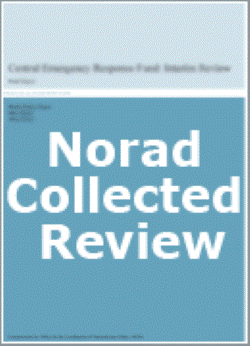Baraza La Habari Tanzania – Mid-Term Review Of The Programme Strategy 2008-2011
Om publikasjonen
- Utgitt: august 2010
- Serie: Norad-innsamlede rapporter
- Type: --
- Utført av: Kazi Services Ltd
- Bestilt av: Media Council of Tanzania
- Land: Tanzania
- Tema: Media og kommunikasjon
- Antall sider: 62
- Serienummer: 4/2010
- ISBN: 978-82-7548-516-6
- ISSN: --
- Prosjektnummer: TAN 07/051

The Project
The Media Council of Tanzania (MCT) developed a quadrennial Programme Strategy to cover the period 2007/8 - 2010/11 with the overall goal of expanding the perimeters of freedom of expression and the media in order to ensure that the Tanzanian media contributes effectively in the country’s development and democratic processes. The Council envisions a democratic Tanzania with a free, responsible and effective media. The Programme Strategy identifies four strategic levels to work at, each with programme objectives within 1) Laws, policies and standards, 2) Adjudication of complaints and Media ethics, 3) Quality and investigative journalism, 4) Research, Policy Analysis and Documentation Norway will contributed with 7.4 mill NOK for the period 2007-2011.
Interesting Findings
Major Achievements: The first year of the programme strategy was seen as a transitional year because MCT was engaged in building its internal capacity. MCT has to a great extent worked on all components. The most visible achievements include: improved internal capacity; strengthened capacity of UTPC; re-engineered website; gained confidence and trust of stakeholders including the government; managed to stop the passing of the undesirable government sponsored bills; improving the quality of training in ethical reportage; created courage and skills amongst journalist to do investigative journalism; peer oversight amongst journalists especially on ethical issues; tangible achievements in research; high quality publications; and establishment of the Tanzania Editors’ Forum.
Limitations: Most media houses are far from achieving editorial independence. MCT has not been able to influence business community and media houses to promote editorial independence. Shallow journalism still dominates both print and electronic media. MCT can only coordinate other stakeholders to influence the government to set standards and regulate media profession.
MCT does not have funds to do wide public advertisements. Efforts have been directed to lobbying support from media houses to air and print the adverts free of charge or on discounted rate cards.
MCT does not have a robust enough Monitoring and Evaluation system to produce real time reports; and adequately capture results and outcomes during implementation.
Threats: The programme strategy is broad and ambitious, hence, poses the risk of doing too much and losing sight. The achievement of some strategic objectives depends on the engagement of other stakeholders with likelihood of slowing down the pace of implementation. Managing stakeholders’ expectations may be challenging. MCT should use public advertisements to promote its position and core functions.
Conclusions: The programme strategic objectives are still relevant and are addressing pertinent issues; however there is a scope for changing the approach in implementing the strategy. The main issue lies with how the objectives are implemented and how the focus should change to improve the effectiveness of MCT engagement. MCT needs to move from implementing some of the activities to coordinating other actors in the media and related sectors. The analysis of other actors in MCT strategic objectives should provide a guideline as to what MCT has to look for synergy and coordinate to achieve desirable outputs.
